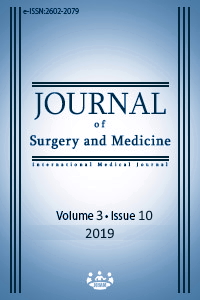Effect of peri-operative milrinone on pulmonary artery pressure in patients undergoing mitral valve replacement
Keywords:
Mitral valve disease, Pulmonary artery pressure, Mitral valve replacementAbstract
Aim: Increased pulmonary artery pressure is associated with higher surgical risk in patients undergoing mitral valve replacement. The aim of this study was to investigate the effect of milrinone on the pulmonary artery pressures of patients with mitral valve disease (stenosis or regurgitation) who underwent mitral valve replacement surgery.
Methods: In this case-control study, 48 patients with mitral valve disease who underwent mitral valve replacement surgery were included. The patients were divided into a control group of 30, who were not administered milrinone, and a study group of 18 who received milrinone perioperatively. Systolic pulmonary artery pressures (SPAP), left ventricle ejection fractions (LVEF) and the following postoperative outcomes were recorded: low cardiac output syndrome, stroke, renal failure, bleeding, ventricular arrhythmia and mortality occurring within 30 days of surgery either in or out of the hospital.
Results: In the study group, preoperative LVEFs and postoperative low cardiac output syndrome were lower (72.0 (6.1) vs 62.5(8.4) P<0.001 and P=0.007, respectively), SPAPs were higher (45.50 (7.0) vs 55.06 (5.5), P<0.001), and length of stay in intensive care unit was significantly shorter (4.7 (2.2) vs 3.2 (0.5), P=0.008). Also, reduction in both postoperative SPAP and 30-day SPAP were significantly higher [-11.40(-13.25-(-8.63)) vs -4.42(-5.89-(-2.80)), P<0.001; -13.6(-15.6-(-9.75)) vs -5.56 (-7.20-(-3.30)), P<0.001, respectively].
Conclusion: We found that using perioperative milrinone reduces the systolic pulmonary artery pressure and lowers the rate of low cardiac output syndrome. Milrinone can be used as an effective therapy to reduce to pulmonary pressure in patients with pulmonary hypertension undergoing mitral valve replacement surgery.
Downloads
References
Maeder MT, Weber L, Buser M, Gerhard M, Haager PK, Maisano F, et al. Pulmonary Hypertension in Aortic and Mitral valve Disease. Front Cardiovasc Med. 2018;5:40.
Ghoreishi M, Evans CF, DeFilippi CR, Hobbs G, Young CA, Griffith BP, et al. Pulmonary hypertension adversely affects short- and long-term survival after mitral valve operation for mitral regurgitation: implications for timing of surgery. J Thorac Cardiovasc Surg. 2011;142(6):1439-52.
Hernandez AF, Li S, Dokholyan RS, O'Brien SM, Ferguson TB, Peterson ED. Variation in perioperative vasoactive therapy in cardiovascular surgical care: data from the society of thoracic surgeons. Am Heart J. 2009;158:47–52.
Zangrillo A, Biondi-Zoccai G, Ponschab M, Greco M, Corno L, Covello RD, et al. Milrinone andmortality in adult cardiac surgery:a meta-analysis. J Cardiothorac Vasc Anesth. 2012;26:70–7.
Le Tourneau T, Richardson M, Juthier F, Modine T, Fayad G, Polge AS, et al. Echocardiography predictors and prognostic value of pulmonary artery systolic pressure in chronic organic mitral regurgitation. Heart. 2010;96(16):1311-7.
Alsancak Y, Gurbus AS, Duzenli MA.Transcatheter mitral valve repair and replacement; current therapies and general evaluation of new approaches. J Surg Med. 2017;1(3):56-8.
Landoni G, Lomivorotov VV, Alvaro G, Lobreglio R, Pisano A, Guarracino F, et al. Levosimendan for hemodynamic support after cardiac surgery. N Engl J Med. 2017;376:2021–31.
Feneck RO, Sherry KM, Withington PS, Oduro-Dominah A, European Milrinone Multicenter Trial Group. Comparison of the hemodynamic effects of milrinone with dobutamine in patients after cardiac surgery. J Cardiothorac Vasc Anesth. 2001;15:306–15.
Carmona MJ, Martins LM, Vane MF, Longo BA, Paredes LS, Malbouisson LM. Comparison of the effects of dobutamine and milrinone on hemodynamic parameters and oxygen supply in patients undergoing cardiac surgery with low cardiac output after anesthetic induction. Rev Bras Anestesiol. 2010;60:237–46.
Sardo S, Osawa EA, Finco G, Gomes Galas FRB, de Almeida JP, Cutuli SL, et al. Nitric Oxide in Cardiac Surgery: A Meta-Analysis of Randomized Controlled Trials. J Cardiothorac Vasc Anesth. 2018;32(6):2512-9.
Indolfi C, Piscione F, Perrone-Filardi P, Prastaro M, Di Lorenzo E, Sacco L, et al. Inotropic stimulation by dobutamine increases left ventricular regional function at the expense of metabolism in hibernating myocardium. Am Heart J. 1996;132:542–9.
Schulz R, Rose J, Martin C, Brodde OE, Heusch G. Development of short-term myocardial hibernation. its limitation by the severity of ischemia and inotropic stimulation. Circulation. 1993;88:684–95.
Levy JH, Bailey JM, Deeb GM. Intravenous milrinone in cardiac surgery. Thorac Surg. 2002;73(1):325-30.
Burkhardt BE, Rücker G, Stiller B. Prophylactic milrinone for the prevention of low cardiac output syndrome and mortality in children undergoing surgery for congenital heart disease.Cochrane Database Syst Rev. 2015;(3):CD009515.
Hashim T, Sanam K, Revilla-Martinez M, Morgan CJ, Tallaj JA, Pamboukian SV, et al. Clinical Characteristics and Outcomes of Intravenous Inotropic Therapy in Advanced Heart Failure.Circ Heart Fail. 2015;8(5):880-6.
Oztekin I, Yazıcı S, Oztekin DS, Goksel O, Issever H, Canık S. Effects of low-dose milrinone on weaning from cardiopulmonary bypass and after in patients with mitral stenosis and pulmonary hypertension. Yakugaku Zasshi. 2007;127(2):375-83.
Wang H, Gong M, Zhou B, Dai A. Comparison of inhaled and intravenous milrinone in patients with pulmonary hypertension undergoing mitral valve surgery. Adv Ther. 2009;26(4):462-8.
Ushio M, Egi M, Wakabayashi J, Nishimura T, Miyatake Y, Obata N, et al. Impact of Milrinone Administration in Adult Cardiac Surgery Patients: Updated Meta-Analysis. Cardiothorac Vasc Anesth. 2016;30(6):1454-60.
Downloads
- 1993 1721
Published
Issue
Section
How to Cite
License
Copyright (c) 2019 Ahmet Dolapoğlu, Eyüp Avcı
This work is licensed under a Creative Commons Attribution-NonCommercial-NoDerivatives 4.0 International License.
















